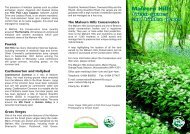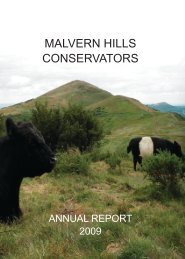Footpath degradation of the Malvern Hills - Malvern Hills Conservators
Footpath degradation of the Malvern Hills - Malvern Hills Conservators
Footpath degradation of the Malvern Hills - Malvern Hills Conservators
You also want an ePaper? Increase the reach of your titles
YUMPU automatically turns print PDFs into web optimized ePapers that Google loves.
Stephen Britnell<br />
<strong>Footpath</strong> <strong>degradation</strong> <strong>of</strong> <strong>the</strong> <strong>Malvern</strong> <strong>Hills</strong><br />
Erosion increases with <strong>the</strong> increase in slope angle, and slope length. This is due to<br />
<strong>the</strong> increase in velocity and volume <strong>of</strong> surface run<strong>of</strong>f, and <strong>the</strong> erosive power <strong>of</strong> walkers is<br />
greater going up hill. Also on a slope rainsplash is greater in <strong>the</strong> downslope direction than<br />
upslope, and so increases transportation <strong>of</strong> particles (Morgan 1995). The relationship<br />
between erosion and slope can be expressed by <strong>the</strong> equation (see Figure 1.) by Zingg<br />
(1940).<br />
Vegetation acts as a protective layer between <strong>the</strong> atmosphere and <strong>the</strong> soil. Above<br />
ground components, such as leaves and stems, absorb some energy <strong>of</strong> falling raindrops.<br />
Below ground components, comprising root systems contribute to <strong>the</strong> mechanical strength <strong>of</strong><br />
<strong>the</strong> soil (Sharma et al. 1989). Plant cover provides resistance from recreational pressure and<br />
dissipates <strong>the</strong> energy <strong>of</strong> running water and so reduces <strong>the</strong> erosive power <strong>of</strong> overland flow.<br />
However this is only true for dense uniform vegetation cover. Clumps <strong>of</strong> vegetation are less<br />
effective and may lead to concentrations <strong>of</strong> flow with localised high velocities. (Morgan 1995)<br />
1.4 Wea<strong>the</strong>ring<br />
Wea<strong>the</strong>ring as well as erosion contributes to <strong>the</strong> <strong>degradation</strong> <strong>of</strong> upland regions.<br />
Wea<strong>the</strong>ring occurs over a longer period <strong>of</strong> time than erosion, and <strong>the</strong> effects may not be<br />
noticed for hundreds <strong>of</strong> years, however <strong>the</strong> wea<strong>the</strong>ring <strong>of</strong> rocks causes <strong>the</strong>m to become<br />
awkward to walk upon, and so contributes to <strong>the</strong> problem <strong>of</strong> footpath divergence and<br />
widening.<br />
“Wea<strong>the</strong>ring is <strong>the</strong> breakdown and alteration <strong>of</strong> materials near <strong>the</strong> earth’s surface to<br />
products that are more in equilibrium with newly imposed physio-chemical conditions.” Ollier<br />
(1984)<br />
Physical wea<strong>the</strong>ring is <strong>the</strong> breakdown <strong>of</strong> material by entirely mechanical methods<br />
brought about by a variety <strong>of</strong> causes. The main processes at work are frost wea<strong>the</strong>ring, salt<br />
wea<strong>the</strong>ring, insulation, moisture swelling, slaking, and abrasion. Frost wea<strong>the</strong>ring is <strong>the</strong> most<br />
18





